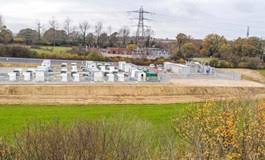UK Energy Department BEIS has confirmed that large-scale energy storage projects will be exempted from the national planning regime.
The UK government will introduce secondary legislation on 14 July that will remove electricity storage, except pumped hydro, from the Nationally Significant Infrastructure Projects regime in England and Wales.
Previously, energy storage projects were treated as generation under the planning regime, which adds 18 months to project’s development time-frame and increases planning costs.
This had led many developers to limit standalone projects to 50 MW and also impacted co-located generation and storage projects.
The changes will instead allow most electricity storage technologies (excluding pumped hydro) to progress through the Town and Country Planning Act, effectively slashing the permission to progress projects over 50 MW, to between eight and 16 weeks.
The Electricity Storage Network (ESN) said as a result of the ruling no storage projects (except pumped hydro) will need to go through the national planning regime. ESN policy lead Madeleine Greenhalgh said: “This is a significant, positive and well-timed decision from the government; encouraging larger storage projects to come forward will add more jobs and economic benefit to the green recovery. “By recognising the smaller planning impacts of storage projects, this change will save developers time and money and encourage more ambitious storage projects, which are vital to decarbonising our electricity system.”
RenewableUK policy and regulation director Rebecca Williams said: “This scale of battery is becoming the new norm. Today’s announcement will stimulate investment in the energy system we need to reach net zero as fast and as cheaply as possible.”
Pivot Power chief executive Matt Allen said policy certainty is “vital” to moving any market forward. He added: “The UK needs gigawatts more energy storage over the coming decades to support more renewables and meet our net zero commitments. “We welcome today’s announcement from government, which will make it easier for developers like ourselves to build energy storage projects at the scale and speed required.”
Solar Trade Association (STA) chief executive Chris Hewett said: “We welcome the decision to make it easier to deploy flexible large-scale energy storage technologies in the UK, which will help to further decarbonise and improve the resilience of our energy system.” “The next steps in unlocking the potential of energy storage, and maximising the crucial role it can play in managing growing solar and wind output, are to provide greater access to flexibility markets, including the capacity market, and applying fairer network charging rules.”
STA has calculated there is currently in excess of 13.5 GW of battery storage projects in the pipeline, with 1.3 GW ready to build, 5.7 GW with planning permission and a further 6.5 GW proposed.
Vattenfall renewable development manager Jake Dunn said: “The Government’s decision to ease planning restrictions, so that more and larger energy storage can be installed is absolutely the right way to go. “The UK will never be free from fossil-fuels until electricity storage is part of our energy system, but the volumes of power we need to be able to store are huge. “However, it’s crucial that storage is co-located at solar and wind farm sites, due to the significant logistical and cost benefits that co-location offers for grid connections and land.”
Renewable Energy Agency policy head Frank Gordon added: “Whilst this is a positive development, we must remember that there are a matrix of changes that need to be made to the way our grids and energy system are managed if we are to fully decarbonise.“We welcome other recent announcements to this end, including the regulator’s proposal to increase the allowable spending by the Electricity System Operator so that they can develop their control room to fully capture the benefits of a more local and dynamic system.”

